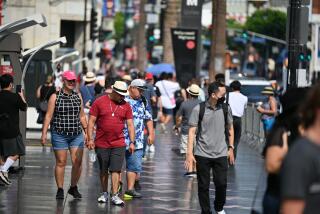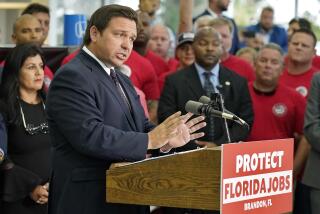UPDATE : Violent Image Still a Dark Cloud Over Florida Tourism
- Share via
MIAMI — Of course, the tourism delegation Miami dispatched to London and Frankfurt, Germany, earlier this month talked up the $5.6 billion being spent to renovate hotels, replenish the beaches and improve the highways here. And the group passed out plenty of brochures featuring palm trees, tropical drinks and fun in the sun.
But perhaps most important--and most unusual--in the delegation’s pitch to European travel writers and tour operators was the presence of John S. Farrell, who is one of greater Miami’s top cops. His job: Assure prospective British and German visitors that a vacation in Florida need not be fatal.
“Don’t leave your common sense at home,” advised Farrell, who then cited statistics showing robberies of tourists down by 56% this year compared with 1993.
“Crime and safety are the No. 1 issue,” said Mayco Villafana of the Greater Miami Convention and Visitors Bureau. “We need to put it behind us, and I think we did.”
Nonetheless, tourism officials throughout Florida agree that the outlook remains gloomy. Florida’s $32-billion tourism industry is still reeling from a series of highly publicized assaults on foreign visitors, including the murder of Briton Gary Colley in September, 1993. The number of visitors from Germany and Britain plunged by as much as 50% last winter, and this year Florida tourism in general is flat.
“Business is extremely soft, and it’s going to continue,” said Bill Sims, who runs several central Florida theme parks and chairs the state Tourist Commission.
While crime and a weakened European economy are cited as the major reasons for the drop in Florida visitors, many feel that tourists also are forsaking Florida for fresher attractions.
Many Florida hoteliers and others in the tourism industry backed casino gambling as a way out of the doldrums. But despite a $16-million advertising campaign, 60% of state voters on Nov. 8 rejected a proposal to open 47 gaming parlors around the state.
The gambling issue did win the favor of southern Florida voters, and the Greater Miami Convention and Visitors Bureau supported it as well.
But Gov. Lawton Chiles and his Administration opposed it. Florida Commerce Secretary Charles Dusseau called the ballot measure “an attempt at a hostile takeover of Florida’s . . . tourism industry by outside gambling interests.”
A third of the $1.6-million anti-casino effort came from Orlando’s Walt Disney World, which reportedly has its own visitor problems. Attendance has declined by almost 5 million a year, to 28.9 million, from a peak four years ago, according to the Orlando Sentinel.
The drop-off at Disney World, by far the single most popular draw among Florida tourists, reflects the statewide trend. In 1993, a record 41 million tourists--both domestic and foreign--came to the Sunshine State. This year’s total is expected to be half a million less.
This month, Florida unveiled a new ad campaign centered on the slogan “Return to your senses in Florida,” which focuses on the restorative benefits of lying on the beach. But the $4.2-million cost of the campaign, consisting chiefly of TV spots in Northern markets, eats up almost two-thirds of the state’s annual advertising budget of $6.7 million.
“Florida is being outspent by other states, by Mexico, by countries in the Caribbean,” said Gary Stogner of Florida’s Division of Tourism.
The Tourist Commission, an advisory board of people in the industry, has suggested a $40-million ad campaign to redefine and sharpen the state’s image.
“Image is still a problem,” Stogner admits.
Indeed. The day after the Miami tourism delegation left for home, for example, the London Sunday Telegraph published a story on the Floridians’ visit that made reference to the murder of Colley. That shooting took place at a highway rest stop outside Tallahassee, which is 470 miles north of Miami.
The headline on the article: “City of crime tries to woo back British.”
More to Read
Sign up for The Wild
We’ll help you find the best places to hike, bike and run, as well as the perfect silent spots for meditation and yoga.
You may occasionally receive promotional content from the Los Angeles Times.






